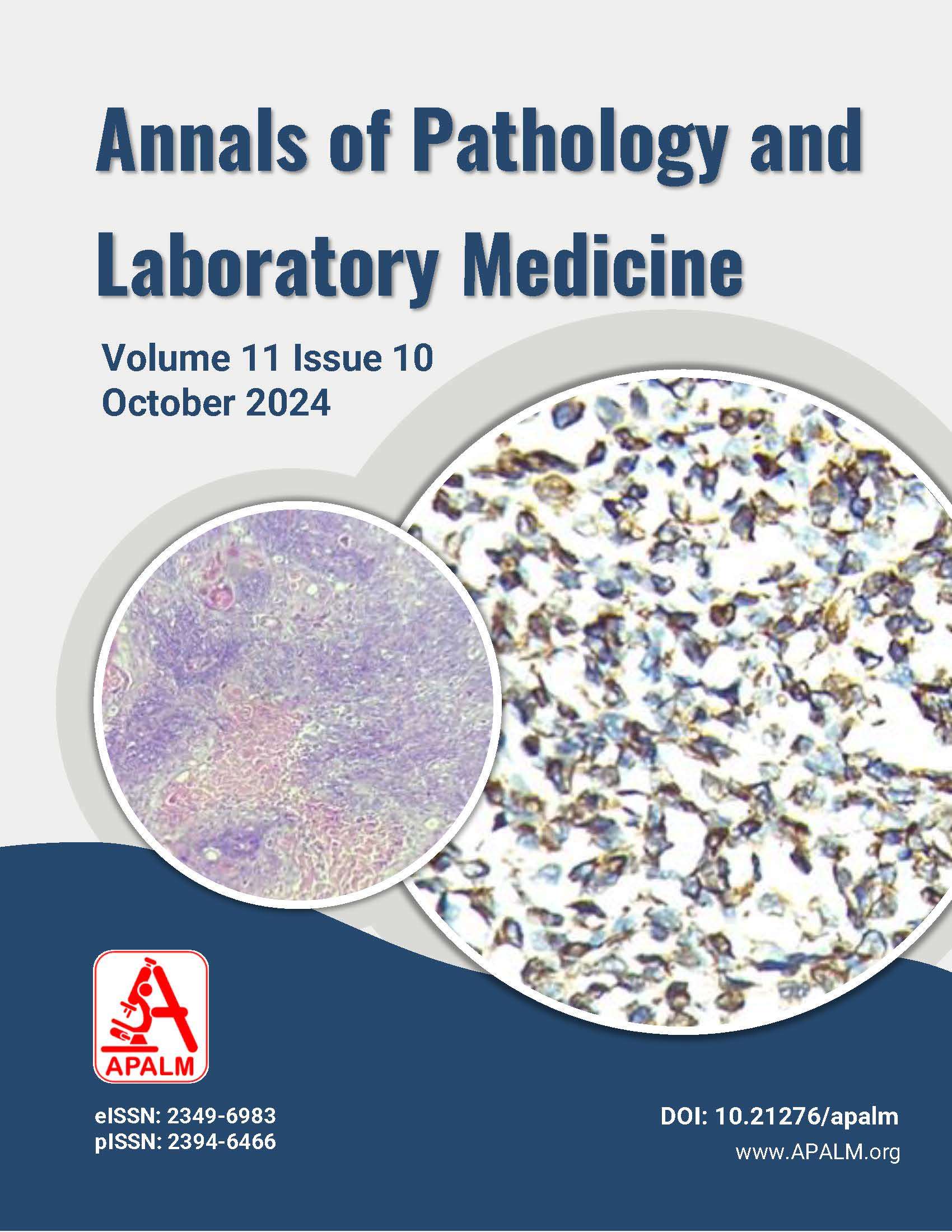Expression of Androgen Receptor in Breast Carcinoma and Its Correlation with Estrogen, Progesterone, and Human Epidermal Growth Factor Receptor-2 Status
DOI:
https://doi.org/10.21276/apalm.3392Keywords:
Androgen Receptor, Estrogen Receptor, Human Epidermal Growth Factor Receptor-2, Progesterone ReceptorAbstract
Background: Breast cancer is the second most common cancer overall and the most common cancer in women. Immunohistochemistry has become a prerequisite in diagnosing, deciding therapy, and predicting prognosis for carcinoma breast. Despite this, it is still difficult to find targeted therapies for triple-negative breast cancer. Many therapies based on the use of androgen receptor agonists or antagonists are emerging. This study was intended to find the prognostic and therapeutic use of androgen receptors in breast carcinoma cases.
Methods: This study was conducted in the Department of Pathology at Bhagat Phool Singh Government Medical College for Women, Khanpur Kalan, Sonepat, with 45 histologically confirmed breast cancer cases with known status of ER, PR, and HER-2/neu receptors.
Results: The age of the patients ranged from 21 to 70 years, and the mean age was 48.24 years. Overall positivity for AR was observed in 62.22% of cases. An inverse relationship was observed between AR positivity and histologic grade. AR positivity was higher in cases that were ER-positive (72.72%), PR-positive (76.92%), and HER-2/neu positive (73.33%) in contrast to cases that were ER-negative (58.82%), PR-negative (56.25%), and HER-2/neu negative (56.67%).
Conclusions: The authors concluded that AR is a more frequently expressed marker than other biomarkers in breast carcinoma cases. AR is associated with lower histologic grade and a good prognostic group of NPI. AR is expressed in high percentages in ER, PR, and HER-2/neu positive cases.
References
1. WHO Globocan 2020 World. Factsheets Cancers: Breast Factsheet. IARC; WHO. Available from: https://gco.iarc.fr/today/data/factsheets/populations/900-world-fact-sheets.pdf.
2. Zucca-Matthes G, Urban C, Vallejo A. Anatomy of the nipple and breast ducts. Gland Surg. 2016;5:32-3.
3. Jatoi I. Reconsidering axillary surgery for early breast cancer. Indian J Med Res. 2017;145:155-7.
4. Elston CW, Ellis IO. Pathological prognostic factors in breast cancer. The value of histological grade in breast cancer; experience from a large study with long-term follow-up. Histopathology. 1991;19:403-10.
5. Ellis IO, Al-Sam S, Anderson N, Carder P, Deb R, Girling A, et al. Pathology reporting of breast disease in surgical excision specimens incorporating the dataset for histological reporting of breast cancer. London: The Royal College of Pathologists; 2016. p. 164-8.
6. Wolff AC, Hammond ME, Allison KH, Harvey BE, Mangu PB, Bartlett JM, et al. Human Epidermal Growth Factor Receptor 2 testing in breast cancer: American Society of Clinical Oncology/College of American Pathologists Clinical Practice Guideline Focused Update. Arch Pathol Lab Med. 2018;142:1364-82.
7. Haybittle JL, Blamey RW, Elston CW, Johnson J, Doyle PJ, Campbell FC, et al. A prognostic index in primary breast cancer. Br J Cancer. 1982;45:361-6.
8. Park S, Koo J, Park HS, Kim JH, Choi SY, Lee JH, et al. Expression of androgen receptors in primary breast cancer. Ann Oncol. 2010;21:488-92.
9. Qi JP, Yang YL, Zhu H, Wang J, Jia Y, Liu N, et al. Expression of the androgen receptor and its correlation with molecular subtypes in 980 Chinese breast cancer patients. Breast Cancer Basic Clin Res. 2012;6:83-4.
10. Yu Q, Niu Y, Liu N, Zhang JZ, Liu TJ, Zhang RJ, et al. Expression of androgen receptor in breast cancer and its significance as a prognostic factor. Ann Oncol. 2011;22:1288-94.
11. Alshenawy HA. Prevalence of androgen receptors in invasive breast carcinoma and its relation with estrogen receptor, progesterone receptor, and Her2/neu expression. J Egypt Natl Canc Inst. 2012;24:77-83.
12. Agoff SN, Swanson PE, Linden H, Hawes SE, Lawton TJ. Androgen receptor expression in estrogen receptor–negative breast cancer: immunohistochemical, clinical, and prognostic associations. Am J Clin Pathol. 2003;120:725-31.
13. Astvatsaturyan K, Yue Y, Walts AE, Bose S. Androgen receptor positive triple-negative breast cancer: clinicopathologic, prognostic, and predictive features. PLoS One. 2018;13:827-8.
14. Vellaisamy G, Tirumalae R, Inchara YK. Expression of androgen receptor in primary breast carcinoma and its relation with clinicopathologic features, estrogen, progesterone, and her-2 receptor status. J Cancer Res Ther. 2019;15:989-92.
15. Agrawal AK, Jeleń M, Grzebieniak Z, Zukrowski P, Rudnicki J, Nienartowicz E. Androgen receptors as a prognostic and predictive factor in breast cancer. Folia Histochem Cytobiol. 2008;46:269-76.
16. Isola JJ. Immunohistochemical demonstration of androgen receptor in breast cancer and its relationship to other prognostic factors. J Pathol. 1993;170:31-5.
17. Anand A, Singh KR, Kumar S, Husain N, Kushwaha JK, Sonkar AA. Androgen receptor expression in an Indian breast cancer cohort with relation to molecular subtypes and response to neoadjuvant chemotherapy: a prospective clinical study. Breast Care. 2017;12:160-4.
Downloads
Published
Issue
Section
License
Copyright (c) 2024 Nangru Mayank, Ruchi Agarwal, Kulwant Singh, Mohinder Kumar Garg, Swaran Kaur Saluja, Sunaina Hooda

This work is licensed under a Creative Commons Attribution 4.0 International License.
Authors who publish with this journal agree to the following terms:
- Authors retain copyright and grant the journal right of first publication with the work simultaneously licensed under a Creative Commons Attribution License that allows others to share the work with an acknowledgement of the work's authorship and initial publication in this journal.
- Authors are able to enter into separate, additional contractual arrangements for the non-exclusive distribution of the journal's published version of the work (e.g., post it to an institutional repository or publish it in a book), with an acknowledgement of its initial publication in this journal.
- Authors are permitted and encouraged to post their work online (e.g., in institutional repositories or on their website) prior to and during the submission process, as it can lead to productive exchanges, as well as earlier and greater citation of published work (See The Effect of Open Access at http://opcit.eprints.org/oacitation-biblio.html).










